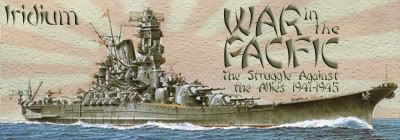Dili
Posts: 4708
Joined: 9/10/2004
Status: offline

|
quote:
There's a difference between criticism and labeling a ship Flawed. I am arguing that Bismarck had strong and weak points, same as any other BB. I do not consider her a "flawed" design anymore than i do Littorio which also had strengths and weaknesses.
If you didnt understood it yet: It is a question of degree. I think the degree is enough to call it that way.
quote:
You said no other incident occured where serious flooding resulted with the Littorio's. That was incorrect. However what i find relevent to your demand that I provide more examples other than Taranto, which you originally brought up, is why I must do so to prove a point when you on the other hand, are only required to cite one incident. That is inconsistant.
No i said "What came different in other hits against similar ships?" very different.
You have to bring others than Taranto because you need to dispute my point that after Taranto things were fixed!!!
After the crew retraining and reorganization (which puts more blame in Leaders than in men contrary to what you have been implying) in what instances Littorio were torpedo hits worse to other general BB's hits that was my question.
quote:
I think i've mentioned it several times now. One; Noone can gurantee that any one class is immune to one type of damage. In relation to this, I do not feel that any other ship would have done much better given the exact same circumstances that day in which Bismarck was badly damaged. While Littorio's redunancy might have assisted her, there is no gurantee that it would have made a difference in the end, especially in those sea conditions and with the additional damages suffered as it is just as probable that the Littorio's crew would have been just as hindered in making emergency repairs as Bismarck's crew was. You have no problem blaming the crew for Littorio's poor showing at Taranto, saying they were unprepared and/or untrained. Using that same logic one can cite that Bismarck's crew was handicapped by the heavy seas which made it more difficult and dangerous to attempt emergency repairs. In calmer waters, they might have unjammed the rudders and established manual control.
I asked none of that. I asked your opinion if Bismarck could have maneuvered it would have escaped?
quote:
Two: Bismarck's designers opted for a more traditional arrangement as did other nations while the Italians opted for an alternate arrangement that conveyed less overall maneuverability in exchange for redundancy of systems. As Tiornu mentioned several pages back, If not having one main + 2 aux rudders is indicative of a design flaw than all battleships save Littorio were flawed. Myself, I feel that each class traded pros and cons based on what the designers felt was most important to them and that this is an example of such a choice.
Yes they were more or less more vulnerable than Littorio. Bismarck is special because in no other ship all propellers and rudders are so closely placed. Even an hit in the bottom of the sea could have made a disaster, without enemy action. That is why i call it design flaw.
quote:
Three: As mentioned in Garke, and also in this thread by Tironu, the only reason Bismarck's steering arrangement recieves such scrutiny today is because of the lucky hit she recieved that led to her destruction during her maiden voyage. Outside of that hit, I doubt much scrutiny would be made.
And? I can't really understand that line of thinking, of course we talk about that like we talk about Hood deck armor etc. most people, even specialist articles arent making a BB study so talk about what happen of course, if there was a comprenhensive BB study it would have showed up . I am bit off here since it is unsual that someone is opposing the mighty German Battleship Vs floppy Italians that didnt made anything right and when did it was a copy , what would they would be thinking if i would say that they also had probably one of the best steel armor in ships. Btw Is the Hood hit lucky too ? If Hood not hit, Bismarck would be at bottom of Ocean and would not have a fanbase, all failures like not even destroying an airplane would have been shown.
quote:
I didn't say they were equal in maneuverability. What i said, repeatedly, was that a traditional two primary rudder layout conveys more manueverability vs the arrangment chosen for Littorio. This doesn't mean Littorio wasn't maneuverable or that she wasn't more maneuverable than Bismarck...it means she could have been still more manueverable had the designers opted for a different choice. However the Italians preferred redunancy over extra maneuver ability. You can find this in Gazrke's Volume on Axis BB's of WWII. I recommend it. An essential set for battleship enthusiaists.
Okay i understand now , but i dont understand the point you are trying to make then since that doesnt shows a high degree of Littorio vulnerability.
quote:
You are misreading: "The Bismarck class rudder has been criticized as being too small to effectively turn the ship quickly, and is excessively vulnerable compared to the double rudder setup of the American Iowa class. These latter criticisms are justified by the single torpedo hit scored on Bismarck's rudder by Fairey Swordfish torpedo bombers during the British pursuit of the vessel.[14]"
Not misreading. The salient point is "These latter criticisms are justified by the single torpedo hit scored on Bismarck's rudder by Fairey Swordfish torpedo bombers during the British pursuit of the vessel.
You are misreading because who makes that contention: "These latter criticisms are justified" also says "has been criticized" so who have been criticizing Bismarck "as being too small to effectively turn the ship quickly" is another person or persons who doesnt necessarely made that contention.
Here are even other persons: William H. Garzke, Jr. and Robert O. Dulin, Jr.
http://www.navweaps.com/index_inro/INRO_Bismarck_p1.htm
"Locating the rudders midway between the centerline and wing propellers meant that the center to center distance of the rudders was considerably smaller than it would have been in a quadruple-propeller arrangement with the rudders positioned between the propellers on either side. It would appear that the triple-screw arrangement chosen by the German naval constructors resulted in an approximate one-third loss of turning power when compared to a quadruple-screw ship of the same power."
"The need to provide clearance for the centerline propeller also resulted in a longer than usual overhang in which the weights of the rudders, steering gear and the protective armor for the steering gear was located. Buoyancy aft was limited by the smaller immersed volumes that resulted from the cutaway. These characteristics led to problems in German cruisers and battleships when they were torpedoed in the stem. Because of the lighter structure and smaller buoyancy than that found in a quadruple stem form these ships were more prone to damage from the whipping phenomena which occurs when the extremities of a ship are subjected to explosion-induced forces. The spectacular stem failures of the armored cruiser Lützow and heavy cruiser Prinz Eugen were examples of this."
quote:
I stand by what i wrote in response to this assumption based on one hit, particularily given the reference to the torpedo hit does not allow for Bismarck's already damaged condition and the sea state, both of which impeeded her max speed and maneuverability. Despite this she avoided most of the missles aimed at her. I also note that the original claim by you that Bismarck was "flawed design" was based on the steering gear/prop vulnerability due to close proximity to each other. With that argument going nowhere, we now get criticism of Bismarck's turning radius. Yet in reading up on Bismarck and her sister's action vs torpedo planes in Garzke, both ships managed to avoid plenty of torpedoes aimed at them quite competently. It would appear that Bismarck's steering ability worked just fine in RL.
Well that(close proximity of proppeller and rudders) is my main contention of Design flaw like i said even an hit in the bottom could lead to a disaster or a very serious situation. Reading more on Bismarck showed more flaws (maneuverality, strutural deficiencies) that lead me to think the whole back of the ship wasnt well tought.
quote:
I'm highlighting the fact that you keep picking and choosing your design elements in your dismissal of the Bismarck class without acknowledging that its all connected. Your now criticising her ability to turn and as your proof you google up a Wikipedia entry that basically criticises Bismark's ability to steer based on sole fact that the already damaged warship received a lucky hit to the stern. I mention that if Bismarck was not the most maneuverable ship this was due in no small part to the fact that the designers were most concerned with buiding a ship of great stability for firing and ability to absorb damage. One cannot dismiss the importance of stability and strength anymore than one can maneuverability. Further as I already mentioned, based on the battle accounts, Bismarck and Tirpitz both maneuvered just fine in avoiding potential damage.
Read above, you misread. If indeed the (lack of)maneuverality of Bismarck was only due to better stability that would be an understandable trade off. It wasn't.
quote:
I know...and i disagreed and still do. All ships are inherantly vulneable to stern hits by torpedoes and bombs. Littorio's spread out arrangment with reduancies was a good response to the threat at the cost of additional maneuverability and increased area where propulsion and steering damage can occur. Other nations chose more traditional methods. A closer arrangement means a smaller area of vulnerability but increases the danger of collateral damage. In the end there's no guarntee. Despite the closeness of the arrangements, only Bismarck's steering gear was impacted, not her propulsion. One would have thought both would be based on this discussion. By the same token Veneto suffered both propulsion and steering damage despite her more spread out arrangement and at one point was immobilized completely with serious damage.
I totally agree, that is the reason that redundancy is paramount in that area.
I would say that the trade off for Littorio is speed not maneuverality.
So it was a lucky hit but not lucky that the propulsion stayed on? The fact that propulsion stayed on dont denies the higher risk. I didnt imply that in 100 hits there would be 100 failures i implied that there will be an higher risk of failure of whole Steering/Propeller.
Precision:Veneto Steering damage was one of auxilary rudders the other two were ok, like i and you have said redundancy increases complexity and chances something gets hit for the whole system/ship etc. be able to better survive. Speed went fast to 16kt and later to 19kt.
P.S: thanks for the reference on the book.
|
 Printable Version
Printable Version

































 New Messages
New Messages No New Messages
No New Messages Hot Topic w/ New Messages
Hot Topic w/ New Messages Hot Topic w/o New Messages
Hot Topic w/o New Messages Locked w/ New Messages
Locked w/ New Messages Locked w/o New Messages
Locked w/o New Messages Post New Thread
Post New Thread